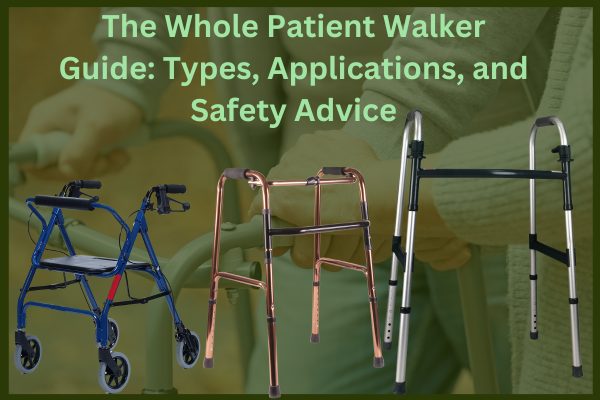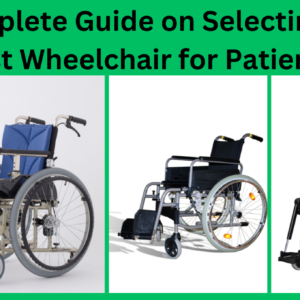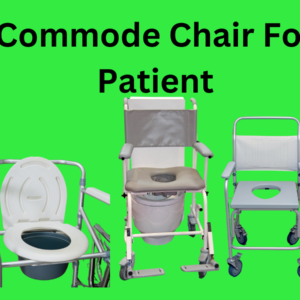The Whole Patient Walker Guide: Types, Applications, and Safety Advice
A patient walker is a type of mobility aid intended to help people who have weakness, balance problems, or are recovering from surgery. Walkers assist people in moving safely and independently by giving them confidence, support, and stability.
Everything you need to know about patient walkers will be covered in this book, including types, advantages, how to use them properly, safety advice, and adjusting to full mobility.
Contents Table
Overview of Patient Walkers
Who Requires a Walker?
Walker Types: Standard Walker
Walker with Two Wheels
Walker on Three Wheels
Rollator with Four Wheels
Walker on the Knee
Walker, Hemi
Walker Upright
Advantages of Walker Use
How to Pick the Best Walker
Using a Walker Rightly
Walker Safety and Comfort Accessories
Making the Switch from Walker to Complete Mobility
Common Errors to Steer Clear of When Using a Walker
Walker Upkeep and Safety Advice for Walker Users
Final Questions and Answers
1. Overview of Patient Walkers
A walker is a medical device that helps persons who have trouble moving about. For people recuperating from surgery, trauma, or illnesses that impair walking abilities, it offers stability and support. Walkers lower the danger of falls while assisting people in regaining their independence.
2. Is a Walker Necessary?
People who may need a walker include:
have trouble balancing as a result of disease, age, or accident.
are recuperating following surgery on the leg, knee, or hip.
suffer from joint discomfort or muscle weakness brought on by diseases like arthritis.
possess neurological conditions (e.g., stroke recovery, Parkinson’s disease).
require assistance following a prosthetic limb change or amputation.
3. Walker Types
1. Walker Standard (No Wheels)
A simple four-legged walker with rubber grip tips.
offers the greatest stability, but moving it takes lifting.
Ideal for people who have serious balance problems or are recovering from surgery.
2. Walker on Two Wheels
features two back legs with rubber tips and two front wheels.
provides stability and a certain amount of mobility.
Perfect for those who can move their legs but require assistance due to a lack of strength.
3. Walker on Three Wheels
A three-wheeled, lightweight walker that provides greater mobility.
frequently has hand brakes, a seat, and a basket.
Less stable than four-wheel walkers, yet excellent for outdoor use.
4. A Rollator with Four Wheels
A four-wheeled, seat-equipped walker with brakes.
maximizes movement but necessitates balance.
Ideal for elders who are active or who occasionally need to relax.
5. Knee Walker (also known as a knee scooter): a wheeled walker with a cushioned knee rest.
Perfect for fractures of the foot or ankle or other non-weight-bearing leg injuries.
6. Walker, Hemi
A one-sided, cane-like walker.
Ideal for people who are weak on one side (stroke sufferers, for example).
7. The Upright Walker
intended to lessen back strain by encouraging improved posture.
includes height adjustment and forearm support.
Perfect for those who have hunching or spinal difficulties.
4. Advantages of Walker Use
increases freedom and mobility
enhances stability and lowers the chance of falls.
offers assistance after surgery.
enhances balance and posture
enables people to confidently walk greater distances
5. How to Pick a Good Walker
The following factors should be taken into account when choosing a walker: ✔ User strength and balance: Rollators are preferable for active users, while standard walkers are best for those with severe balance problems.
✔ Weight capacity: Verify that the walker can sustain the weight of the user.
✔ Storage and portability: Foldable walkers make traveling easier.
✔ Seat and brake options: Rollators with seats and brakes offer even more convenience.
✔ Indoor versus outdoor use: For outdoor terrain, larger wheels are preferable.
6. Walker Operation Rightly
Set the walker’s height so that, when standing up straight, the handles are at wrist level.
Avoid walking behind the walker and instead enter it.
Step toward the walker after moving it forward.
Maintain a steady pace; don’t hurry or take big steps.
When stopping, use the brakes (if necessary) to avoid rolling.
7. Walker Safety and Comfort Accessories
Walker baskets and trays: Used to transport personal belongings.
Hand fatigue can be decreased using padded hand grips.
Glide caps or tennis ball covers can improve mobility.
Convenience is increased with bags and cup holders.
8. Making the Switch from Walker to Complete Mobility
Leg muscles can be developed by strengthening workouts.
Training for balance will help you become more coordinated.
gradually switching to a cane if necessary.
Walking regularly in a secure setting is recommended.
9. Common Errors to Steer Clear of When Using a Walker
🚫 Improper height adjustment might lead to problems with posture.
Excessive reliance on the walker diminishes its efficacy.
🚫 Fall risk is increased by moving too quickly or by lifting the walker incorrectly.
🚫 Ignoring safety features, such as brakes, might result in mishaps.
10. Care and Maintenance for Walkers
Regularly inspect wheels and rubber tips for wear.
Dust and grime can be eliminated by cleaning the walker.
To guarantee stability, tighten any loose joints and screws.
11. Safety Advice for Walker Users
✅ Wear appropriate shoes: Steer clear of heels and slippers.
Steer clear of slick surfaces: Wet floors and rugs can lead to falls.
✅ Don’t overdo it; take pauses when necessary.
✅ Make sure your house is set up correctly by removing obstructions and adding grab bars.
12. In conclusion
For those recuperating from injuries or dealing with mobility issues, a patient walker is a vital mobility tool that offers stability and independence. Careful preparation and progressive practice are necessary for selecting the appropriate walker, using it appropriately, and achieving full mobility. Users can safely rebuild their walking confidence using the appropriate method.
13. FAQ 1. How can I determine if I require a walker?
A walker could increase your mobility and safety if you have frailty, fall frequently, or have trouble walking long distances.
2. What distinguishes a rollator from a walker?
A rollator, which has four wheels, a seat, and brakes, offers greater movement than a walker, which has two or no wheels. However, it requires superior balance.
3. Can I go upstairs with a walker?
No, stairs are not the intended use for walkers. Installing handrails or using a cane to navigate stairs are options if you require assistance.
4. Is it possible to use a walker outside?
Indeed! Larger-wheeled walkers and rollators are perfect for outdoor use on uneven surfaces.
[Please note: If you want nursing wellness and patient care-related items, then click below my website link and get items easily: https://diseasewellnessbounque.in OR https://amzn.to/40lXGaM my amazon shop]






Reviews
There are no reviews yet.